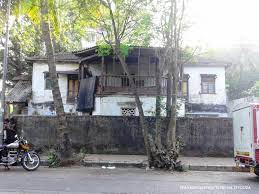


Mumbai: Nestled in the serene enclave of Versova lies a hidden gem - Rattan Kunj, once known as Talati Bungalow, a testament to Mumbai's rich history. This architectural marvel, with its solid Burma teak roof and majestic halls adorned with stained glass, stands as a relic of a bygone era. However, amidst its grandeur lies a tale of controversy and struggle as the Mumbai Municipal Corporation (BMC) issues notices threatening its existence. Built in 1900 AD, Rattan Kunj is one of the last two remaining bungalows of the original Seven Bungalows in Versova. Its origins trace back to a Parsi family, the Talatis, who once owned this magnificent property. Over the years, it has witnessed the ebb and flow of Mumbai's history, surviving the ravages of time and urbanization.
Recently, the BMC issued a notice to the current owners of Rattan Kunj, citing its "ruinous state" and the risk of collapse. However, allegations of a conspiracy to evict the owners surface, with claims that a developer seeks to redevelop the land. Despite efforts to prove its structural integrity through multiple audits, conflicting reports and bureaucratic hurdles plague the preservation efforts. Amidst the bureaucratic quagmire, voices of preservation emerge. The Indian National Trust for Art and Cultural Heritage (Intach) acknowledges Rattan Kunj's structural stability, albeit advocating for minor repairs to maintain its architectural integrity. Conservation architects like Vikas Dilawari emphasize the importance of preserving Mumbai's lesser-known suburban history, highlighting the dwindling number of such architectural marvels amidst redevelopment pressures. The case of Rattan Kunj epitomizes the challenges faced by historical structures in Mumbai's relentless march towards urban development. Conflicting audit reports, allegations of vested interests, and bureaucratic red tape underscore the complexities of heritage preservation in a rapidly evolving cityscape. Moreover, the lack of independent evaluation mechanisms, as highlighted by MLAs in the assembly, further complicates the matter.
Despite the odds, efforts to save Rattan Kunj persist. Advocacy groups, conservationists, and concerned citizens rally behind the cause, urging authorities to reconsider the demolition order. Proposals for an appropriate conservation plan, as suggested by Intach, offer a glimmer of hope for Rattan Kunj's future. However, the path to preservation remains fraught with challenges, requiring collective action and sustained advocacy to safeguard Mumbai's architectural heritage.
Rattan Kunj stands as a symbol of Mumbai's rich cultural heritage, a testament to its storied past. As the city marches towards modernity, the preservation of such historical landmarks becomes imperative. The battle for Rattan Kunj reflects a larger struggle for heritage conservation in Mumbai, highlighting the need for proactive measures to safeguard its architectural legacy. In the face of adversity, let us unite in our efforts to preserve Mumbai's hidden treasures for generations to come.

News Articles
Other Real Estate News Articles